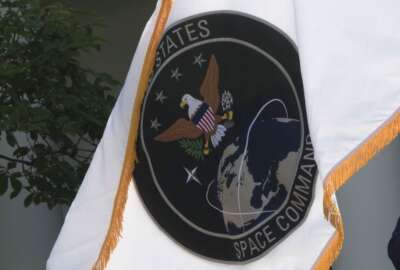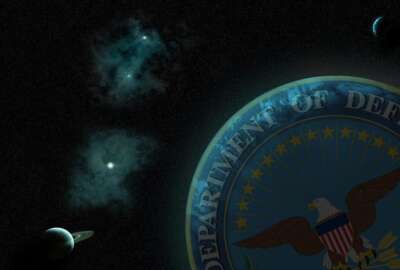
First Look
Inside the Space Force’s push to integrate and change acquisition
The Space Acquisition Council will have its first meeting in April
Despite threats from the coronavirus, the Space Force is still moving full steam ahead setting itself up as the newest military service.
“The current environment hasn’t slowed our ability to do any space operations. There have been no bumps or hiccups in the road,” Shawn Barnes, the point man for space integration and acquisition told Federal News Network. “We are moving out as rapidly as we can on standing up the Space Force.”
Barnes ironically spent time at the Agriculture Department in the 1980s assisting vaccine development for dangerous infectious animal diseases.
But today, his focus is less on the microscopic and more on the macroscopic in helping to set up a force around a military domain that is the size of the universe.
One of Barnes’ roles is helping set up the Space Acquisition Council, which will oversee the many facets of space procurement in the Defense Department — a main selling point for the creation of the Space Force was the consolidation of the acquisition process.
“We will have the first meeting of the council in the April timeframe,” Barnes said. “It may end up being a virtual meeting because of COVID-19. We will see what we need to do. At that meeting we will go over what the charter is, what the council is all about and what are its responsibilities, roles and authorities? Also, what does the law say and what do we recommend the council take on that might go on the strict letter of what it says in the law.”
Barnes said he thinks of the Space Acquisition Council as something that will approve, at a broad level, a space enterprise architecture and the key architectural elements. That includes everything needed for space enhancement missions like GPS, communications, weather and missile warning — which is used by almost all troops — but also, space control missions for protecting space assets.
“That will not be focused on just the Space Force, we will also look at if we are partnered appropriately with other agencies whether that be the intelligence community or other organizations like NASA or NOAA,” Barnes said. “They have space roles that we want to at least think about looking at technology the right way and making use of each other’s infrastructure.”
That goal gets at issues the Government Accountability Office, RAND Corporation and others pointed out as flaws within DoD’s space acquisition – it is disorganized and duplicative..
“There’s integration that needs to be done on a variety of levels,” Barnes said. “There’s one that should be easiest, but is still vexing to the space community, which is to ensure we have integrated properly the space assets, the ground command and control and the user aspect like GPS. GPS should be a relatively simple system, but frankly we’ve have a difficult time making sure we are properly synchronized on.”
Another issue Barnes is working on is procuring equipment when satellites are available and when the command and control system that commands the satellites will be available.
“That is a challenge that I think the Space Acquisition Council at the top level of oversight can ensure we are doing things at the right pace and right time,” Barnes said. “We can also ensure other agencies are all prepared to procure equipment at the right time, so they are putting in their budget when satellites will be available.”
Another thing the council will work on is making sure organizations within the national security sector are integrated.
“We’ve been doing a tremendous amount of work with the National Reconnaissance Office to ensure we understand what their needs are going to be for things like protect and defense, as well as understand what programs they have that we might want to take advantage of,” Barnes said.
For example, NRO and the Space Force are pairing up to develop a space situational awareness program.
During the creation of the Space Force, some critics were concerned that NRO and the service would step on each other’s toes since NRO would retain its space capabilities.
Barnes is also working on establishing clarity between the three space acquisition organizations within DoD: the Space and Missile Systems Center, the Space Development Agency and the Space Rapid Capabilities Office.
On an acquisition level, the Space Force is and will be working with traditional defense contractors, but also nontraditional companies like SpaceX and others.
Because of the nature of space equipment, Barnes said the acquisition process needs to be different than traditional routes.
“There’s not going to be one right way to do space acquisition,” Barnes said. “Buying 500 small satellites will be a very different strategy than four satellites that will do missile warning.”
Barnes said he is working closely with DoD’s acquisition and sustainment office to determine if there needs to be a separate and distinct space acquisition policy or if adjustments to the current system will suit the Space Force’s needs.
Coronavirus hurdles
Meanwhile, as the Space Force is setting up, Chief of Space Operations Gen. Jay Raymond told reporters at the Pentagon Friday that the service is changing some of its training plans.
The Space Flag 20-2 exercise scheduled for late April is now canceled. Raymond said three of the 16,000 airmen assigned to the Space Force have been infected with coronavirus.
The Space Force is providing additional bandwidth for the hospital ship USNS Mercy as it begins to take on patients in California.
The 64 cadets who are scheduled to graduate the Air Force Academy in May and commission directly into the Space Force are still on track with their progress and timeline for swearing in.
Raymond said there is significant telework happening in response to coronavirus, even though the classified nature of the work makes that difficult at times. Those who do need to be on a base are following all DoD guidelines.
“It’s remarkable the progress we’re making,” Raymond said. “We have our first flag and will do a presentation for that. For the naming of our space professionals, we did some crowdsourcing and got over 700 responses. We will be narrowing that down and you will hear and announcement on that in the near future.”
Copyright © 2024 Federal News Network. All rights reserved. This website is not intended for users located within the European Economic Area.
Scott Maucione is a defense reporter for Federal News Network and reports on human capital, workforce and the Defense Department at-large.
Follow @smaucioneWFED





